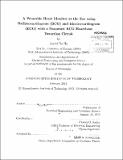| dc.contributor.advisor | Charles G. Sodini. | en_US |
| dc.contributor.author | He, David Da | en_US |
| dc.contributor.other | Massachusetts Institute of Technology. Department of Electrical Engineering and Computer Science. | en_US |
| dc.date.accessioned | 2013-06-17T19:48:36Z | |
| dc.date.available | 2013-06-17T19:48:36Z | |
| dc.date.copyright | 2013 | en_US |
| dc.date.issued | 2013 | en_US |
| dc.identifier.uri | http://hdl.handle.net/1721.1/79221 | |
| dc.description | Thesis (Ph. D.)--Massachusetts Institute of Technology, Dept. of Electrical Engineering and Computer Science, 2013. | en_US |
| dc.description | Cataloged from PDF version of thesis. | en_US |
| dc.description | Includes bibliographical references (p. 132-137). | en_US |
| dc.description.abstract | This work presents a wearable heart monitor at the ear that uses the ballistocardiogram (BCG) and the electrocardiogram (ECG) to extract heart rate, stroke volume, and pre-ejection period (PEP) for the application of continuous heart monitoring. Being a natural anchoring point, the ear is demonstrated as a viable location for the integrated sensing of physiological signals. The source of periodic head movements is identified as a type of BCG, which is measured using an accelerometer. The head BCG's principal peaks (J-waves) are synchronized to heartbeats. Ensemble averaging is used to obtain consistent J-wave amplitudes, which are related to stroke volume. The ECG is sensed locally near the ear using a single-lead configuration. When the BCG and the ECG are used together, an electromechanical duration called the RJ interval can be obtained. Because both head BCG and ECG have low signal-to-noise ratios, cross-correlation is used to statistically extract the RJ interval. The ear-worn device is wirelessly connected to a computer for real time data recording. A clinical test involving hemodynamic maneuvers is performed on 13 subjects. The results demonstrate a linear relationship between the J-wave amplitude and stroke volume, and a linear relationship between the RJ interval and PEP. While the clinical device uses commercial components, a custom integrated circuit for ECG heartbeat detection is designed with the goal of reducing power consumption and device size. With 58nW of power consumption, the ECG circuit replaces the traditional instrumentation amplifier, analog-to-digital converter, and signal processor with a single chip solution. The circuit demonstrates a topology that takes advantage of the ECG's characteristics to extract R-wave timings at the chest and the ear in the presence of baseline drift, muscle artifact, and signal clipping. | en_US |
| dc.description.statementofresponsibility | by David Da He. | en_US |
| dc.format.extent | 137 p. | en_US |
| dc.language.iso | eng | en_US |
| dc.publisher | Massachusetts Institute of Technology | en_US |
| dc.rights | M.I.T. theses are protected by
copyright. They may be viewed from this source for any purpose, but
reproduction or distribution in any format is prohibited without written
permission. See provided URL for inquiries about permission. | en_US |
| dc.rights.uri | http://dspace.mit.edu/handle/1721.1/7582 | en_US |
| dc.subject | Electrical Engineering and Computer Science. | en_US |
| dc.title | A wearable heart monitor at the ear using ballistocardiogram (BCG) and electrocardiogram (ECG) with a nanowatt ECG heartbeat detection circuit | en_US |
| dc.type | Thesis | en_US |
| dc.description.degree | Ph.D. | en_US |
| dc.contributor.department | Massachusetts Institute of Technology. Department of Electrical Engineering and Computer Science | |
| dc.identifier.oclc | 844761372 | en_US |

